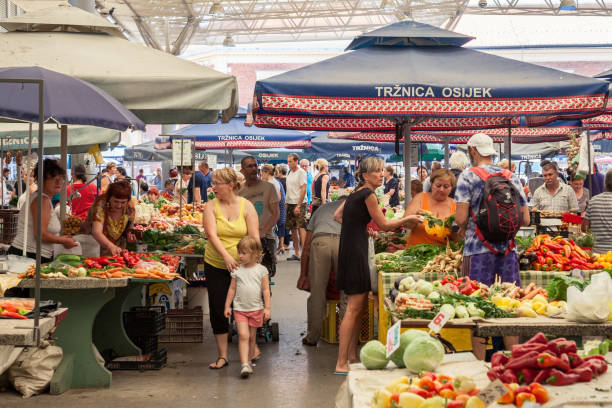Croatia Leans on 100K Foreign Workers in 2025
Jul 23, 2025
Category: Croatia Foreign Workers News

Croatia’s economy is increasingly reliant on foreign labor, with nearly 100,000 international workers now sustaining key sectors like tourism and construction.
As the country braces for another record tourist season, the demand for foreign manpower has evolved from a seasonal stopgap to a structural necessity.
Foreign labor now a pillar of economy
Croatia now employs 99,118 foreign workers, according to new figures from the Ministry of the Interior. That’s not just a statistic; it’s a sign of how deeply global the Croatian workforce has become.
Tourism and hospitality top the demand list, with 35,558 foreign nationals working in the sector. That accounts for more than one-third of all international workers in the country.
And during the peak summer season, many hotels, restaurants, and resorts could not operate without them.
Construction is a close second, employing 28,352 foreign workers. From hotels to highways, urban development continues to expand, driving steady demand for manual labor.
Other vital sectors include:
- Industry: 12,416 workers
- Transport and communications: 7,090 workers
- Retail: 5,045 workers
These numbers show that foreign workers now fill essential roles beyond seasonal tourism. They keep shelves stocked, roads paved, and factories running.
Permit numbers reveal long-term shifts
In just the first half of 2025, Croatia issued:
- 55,020 new residence and work permits
- 31,557 permit renewals
- 12,541 seasonal work permits
That means nearly 100,000 permits were processed between January and June. Most seasonal permits — 11,574 of them — went to tourism workers.
But the high number of renewals and new long-term permits suggests foreign labor is not just passing through. It’s staying.
Dubrovnik-Neretva County alone issued 7,622 permits this year, with over 5,000 for regular jobs. Seasonal work accounted for fewer than 900. That shift hints at a deeper integration of foreign labor into local communities.
Where the workers come from
Croatia’s foreign workforce is as diverse as its coastline is long. The largest groups by nationality include:
- Nepal: 19,207 workers
- Bosnia and Herzegovina: 18,117
- Serbia: 15,214
- Philippines: 9,286
- India: 9,060
Others come from North Macedonia, Kosovo, Egypt, Uzbekistan, and Bangladesh. Many bring construction or hospitality experience and fill gaps where domestic labor is unavailable or insufficient.
This workforce isn’t just global; it’s essential. Without these workers, many businesses say they would shut down or drastically reduce operations.

Why Croatia needs them now
Croatia’s economy leans heavily on services. Tourism alone contributes around 20% to GDP. That creates seasonal labor shortages, especially in coastal cities like Dubrovnik, Split, and Zadar.
Add rising emigration and an aging local population, and the picture sharpens. Fewer young Croatians are staying in the country to take up jobs in hospitality or construction. Others leave for higher wages in Germany, Ireland, or Austria.
The result? A growing vacuum, filled by foreign workers who are willing and able.
As Croatia rebuilds after COVID-19 and expands its infrastructure, the labor shortage isn’t going away. Neither are the foreign workers.
Seasonal boom or structural shift?
Croatia’s reliance on foreign labor, especially in tourism, signals a bustling sector for short-term visitors, but potential staffing shortages could impact service quality.
Long-term visitors may notice cultural diversity but also strain on housing and infrastructure.
The upcoming European Travel Information and Authorization System (ETIAS) could streamline entry for visa-exempt travelers, while Schengen visa policies may tighten scrutiny for workers from non-EU countries.
A crucial foot in the door for migrants
Migrants, particularly from Nepal, Bosnia, and the Philippines, fill critical gaps in Croatia’s tourism and construction sectors. However, seasonal permits and reliance on renewals create job insecurity.
While wages may be higher than in home countries, integration challenges and rights protections remain concerns. The surge in work permits reflects demand, but it also underscores the need for clearer pathways to long-term residency or citizenship.

A test case for labor dependence
Croatia’s labor model mirrors broader EU struggles to balance economic needs with immigration control.
As sectors like tourism and construction rely heavily on foreign workers, pressure mounts for EU-wide policies to standardize seasonal permits or expedite visas for key industries.
Croatia’s experience may push Schengen reforms, blending strict border policies with flexible labor quotas.
A workforce woven from abroad
As Croatia’s tourism and construction sectors thrive, the nearly 100,000 foreign workers have become indispensable, transforming seasonal reliance into a permanent economic pillar.
With record-breaking permits issued and diverse nationalities contributing, the country’s growth story is now written by a global workforce.
The question remains: how will Croatia balance this dependence with long-term sustainability?
